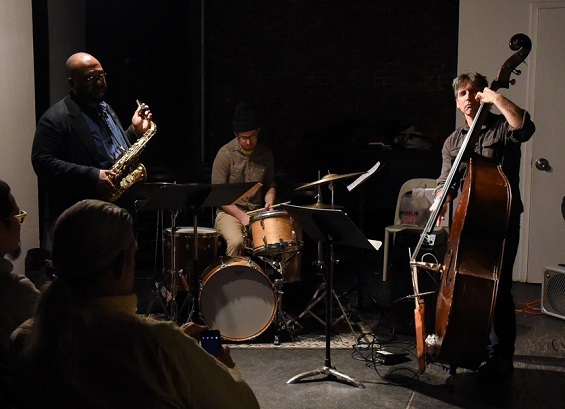
Alto saxophonist Darius Jones recently curated a week at The Stone and I caught the first set that Thursday night. He was playing with his Big Gurl trio, a collaboration with bassist Adam Lane and drummer Jason Nazary. His opening remarks include the observation "I haven't played any of this music in a long time," noting that this was one of his first trios after coming to New York.
It is probably his most traditional jazz group, at least on record, that record being the 2011 AUM Fidelity release Big Gurl (Smell My Dream), which I had trouble enjoying because at that time Jones still had a tendency to play pretty consistently on the high side of the pitch. In jazz, it's possible to have a long and respected career doing this, as shown by Jackie McLean; critics tended to describe his slightly sharp tone with words such as "acidic." But it bugged me. I could hear that Jones was undeniably talented and imaginative, but his tone kept me from loving his music.
People who know my tastes in jazz might be surprised by this; it's not like Albert Ayler worried about such niceties. But playing in an atonal style makes being in tune rather a moot point; in a less outside context, though, such as this trio's composed "heads" (even boppish at times), I find it viscerally upsetting in an entirely uncontrollable reflex. So I looked forward to hearing this band now precisely because Jones has played with a more centered tone in recent years. As a result -- and also because he's become an even more original soloist in the past couple of years than he already was -- I found this trio infinitely more enjoyable this night than it had been for me in the past, even though it was playing the same repertoire. Their musical message was the same, but that miniscule adjustment let me let it communicate to me in a way I hadn't been able to before.
There were some other aspects in Jones's playing that I hadn't noticed before. At times, in his low range, he made the alto sax sound like a bassoon, a striking and attractive timbre that was entirely unexpected, yet every time it came back, it thrilled me, again on a visceral level. There were other aspects I expected, and enjoyed hearing again, notably how he can make what I call "math jazz," complex arrangements with shifting meters and sideways tonality shifts, sound emotive rather than dry and abstract (though I enjoy some of the dry and abstract "math jazz" players as well).
The other players were also impressive. Lane is equally at home walking or vamping or playing free; many of these tunes are kicked off by solo bass figures. Nazary similarly can switch from Sunny Murray-esque skittering to energy playing to grooves to swinging free-bop. Though the players were all using sheet music, they exhibited that crucial jazz balance of sounding tight and loose at the same time, whether on multi-sectional/multi-stylistic arranged sections or in free improvisation. - Steve Holtje
